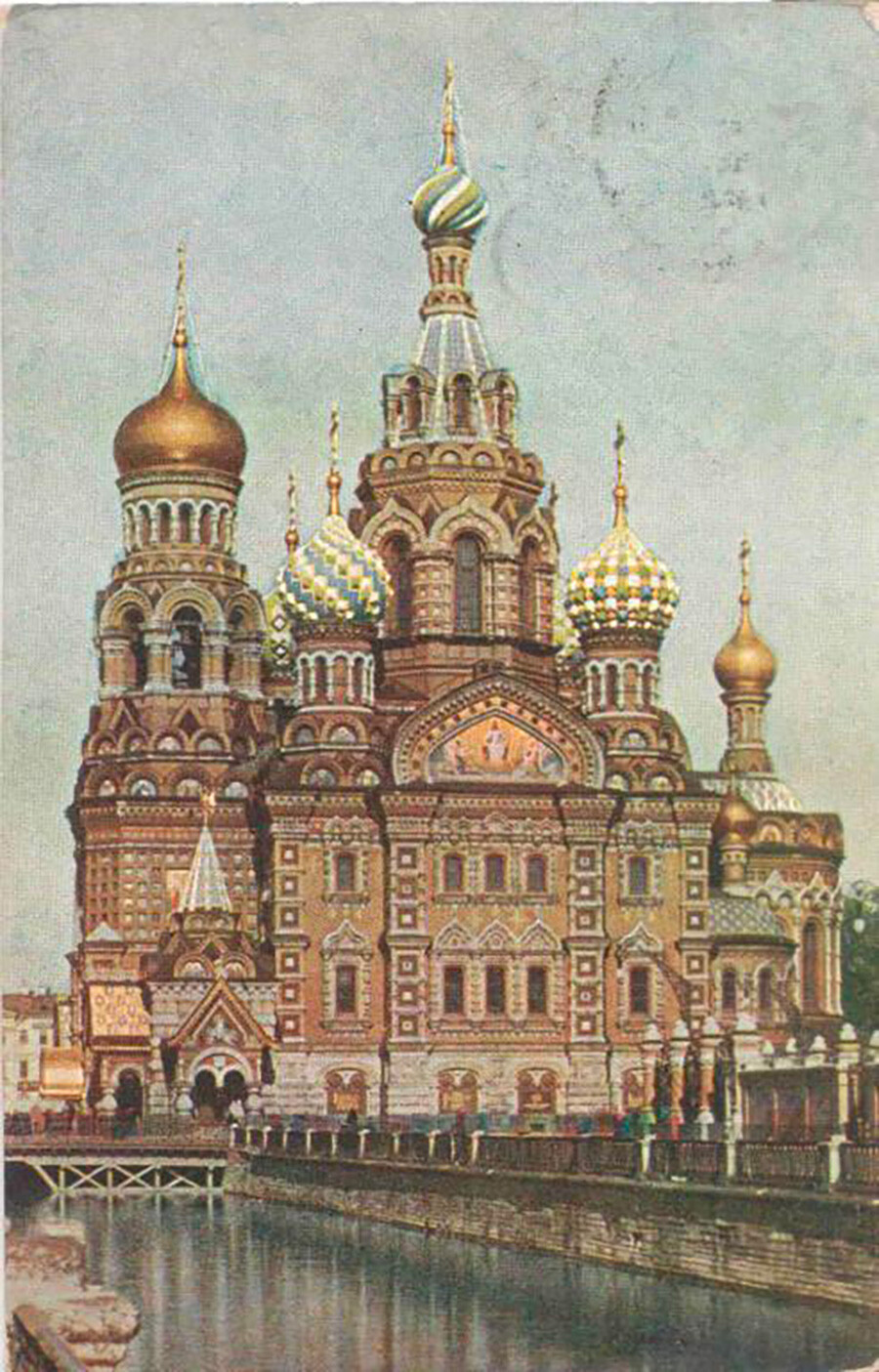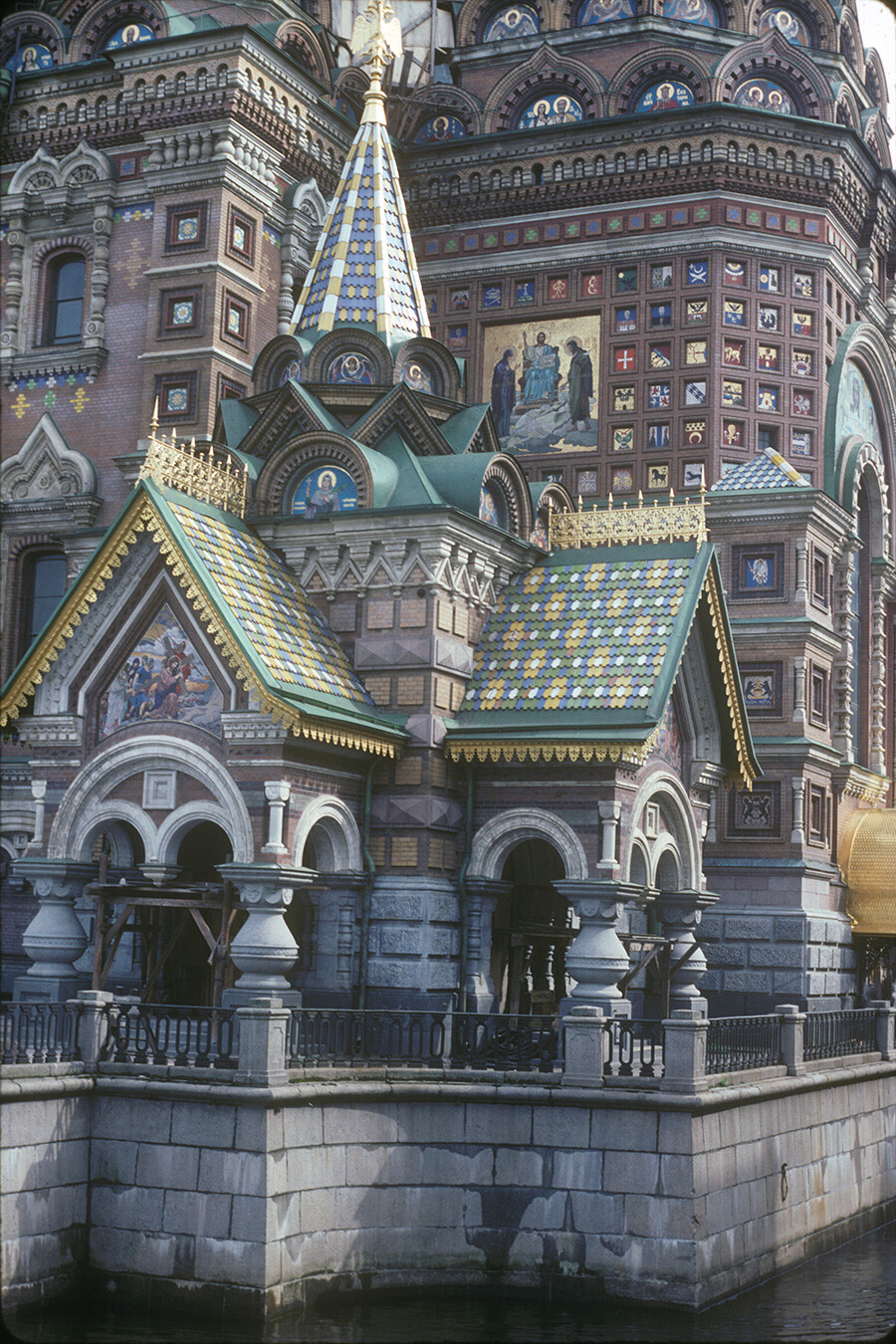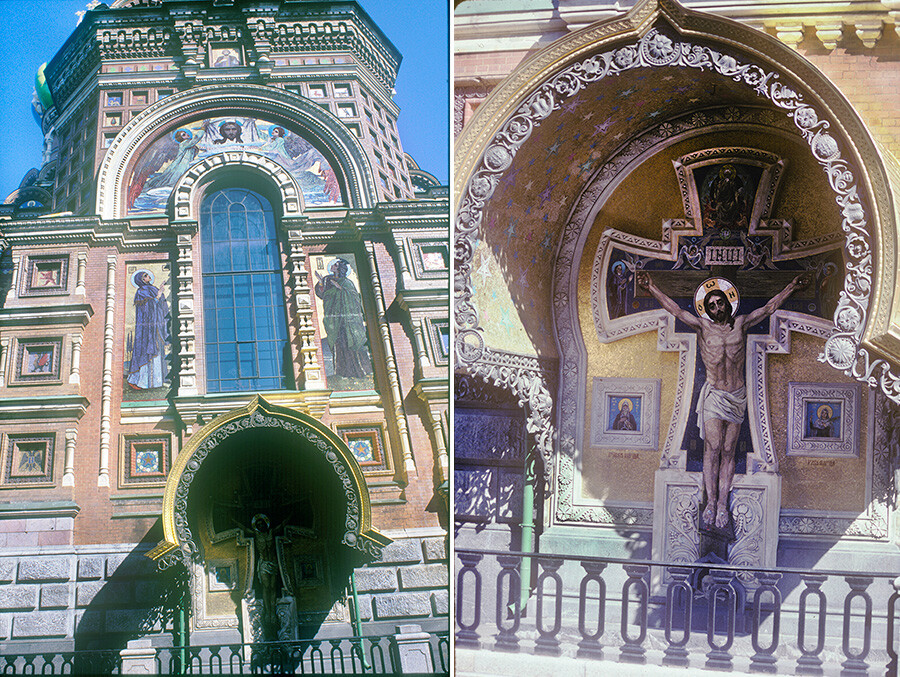Cathedral of the Savior on the Blood: A miracle of creation and survival

 St. Petersburg. Cathedral of the Resurrection of the Savior on the Blood. Southwest view with Griboedov Canal. May 29, 1998
St. Petersburg. Cathedral of the Resurrection of the Savior on the Blood. Southwest view with Griboedov Canal. May 29, 1998
At the beginning of the 20th century, Russian chemist and photographer Sergey Prokudin-Gorsky invented a complex process for vivid, detailed color photography. His vision of photography as a form of education and enlightenment was demonstrated with special clarity through his photographs of architectural monuments in the historic sites throughout the Russian heartland.
 Cathedral of the Resurrection of the Savior on the Blood. South view, circa 1907
Cathedral of the Resurrection of the Savior on the Blood. South view, circa 1907
The main part of the Prokudin-Gorsky collection ultimately became a part of The Library of Congress, but he also established a business that produced color postcards and illustrations in books. This published work included color photographs - presumably taken in 1907 - of one of the most famous monuments in St. Petersburg, commonly known as the Cathedral of the Savior on the Blood.
Russian revival
 Cathedral of the Resurrection. Northwest porch, west view with mosaic panel of Crucifixion by V. M. Vasnetsov. May 25, 2003
Cathedral of the Resurrection. Northwest porch, west view with mosaic panel of Crucifixion by V. M. Vasnetsov. May 25, 2003
St. Petersburg is renowned for its grandiose baroque and neoclassical architectural ensembles such as the Winter Palace and the Admiralty. And yet, the city’s image is no less defined by this highly visible church monument in what is called the Russian Revival or “neo-Russian” style.
The Russian Revival style was often used for secular buildings in the late 19th century, yet the ideology and aesthetics of the style found its richest expression in the design for the Cathedral of the Resurrection of the Savior on the Blood (1883–1907), built on the site where, in March 1881, Alexander II was assassinated by bombs thrown by terrorists of the ‘People’s Will’ political movement.
 Cathedral of the Resurrection. South porch, pediment with mosaic "Descent into Hell" by V. M. Vasnetsov. May 25, 2003
Cathedral of the Resurrection. South porch, pediment with mosaic "Descent into Hell" by V. M. Vasnetsov. May 25, 2003
Although there are varying opinions on Alexander’s historical reputation, he demonstrated support for the United States during the American Civil War and will always be known in Russia as the ‘Tsar-Liberator’ for his abolition of serfdom in 1861. A wooden chapel was soon erected on the site of the assassination in a continuation of a medieval Russian tradition of placing chapels at the site of executions (“on the blood”).
 Cathedral of the Resurrection. South facade, granite panels with inscriptions of notable events in the reign of Alexander II. Shown here: "Treaty of St. Stefano" (left) & "Conquest of Central Asia". May 29, 1997
Cathedral of the Resurrection. South facade, granite panels with inscriptions of notable events in the reign of Alexander II. Shown here: "Treaty of St. Stefano" (left) & "Conquest of Central Asia". May 29, 1997
However, young Tsar Alexander III insisted on a major church as a memorial to his father. After an extensive review of the first designs submitted, all were judged insufficiently “Russian” by Alexander III. In the second competition, Alfred Parland received first prize for a design that included certain features resembling the 16th-century St. Basil’s Cathedral on the Red Square.
Moscow’s influence
 Cathedral of the Resurrection. South view. May 29, 1998
Cathedral of the Resurrection. South view. May 29, 1998
Alfred Parland (1842–1919) graduated from the Imperial Academy of Arts in 1874 and traveled in Europe on a scholarship until 1878, when he returned to the academy as a member of the faculty. He specialized in building churches and, for this preeminent ecclesiastical project of the late 19th century, he turned not to the neo-Byzantine style (the usual official preference, which characterized many of the projects submitted to the competition jury), but to the more “democratic” Russian Revival style, which drew its inspiration from Moscow.
Although both styles enjoyed official favor, the Cathedral of the Resurrection stood distinctly apart from Orthodox churches constructed in the Byzantine manner, both in Russia proper, as well as in other parts of the empire, such as Warsaw. The Russian neo-Byzantine style even extended abroad, as in the Cathedral of St. Alexander Nevsky in Sofia, the capital of Bulgaria.
 Cathedral of the Resurrection. South facade, pediment with mosaic by N. A. Koshelev "Christ in Glory" flanked by St. Alexander Nevsky (left) & St. Nicholas. August 3, 1991
Cathedral of the Resurrection. South facade, pediment with mosaic by N. A. Koshelev "Christ in Glory" flanked by St. Alexander Nevsky (left) & St. Nicholas. August 3, 1991
In contrast, the exterior of the Resurrection Cathedral - particularly its cupolas - suggests 16th and 17th-century Moscow, rather than the ancient shrines of Byzantium or the western-influenced St. Petersburg. With these specifically Russian elements, the Resurrection Cathedral succeeds as a monument to a tsar whose reign was associated with the ideology of Pan-Slavism.
In the final years of his reign, Alexander II had involved Russia in a Balkan war with Turkey (1877-78) that led to the creation of the modern state of Bulgaria. At this time, many Russians, including Fyodor Dostoevsky, awaited the imminent fall of Constantinople (now Istanbul) to Russia, as part of the Orthodox patrimony.
 Cathedral of the Resurrection. Northwest view. June 3, 1999
Cathedral of the Resurrection. Northwest view. June 3, 1999
Like no other structure of the period, the Cathedral of the Resurrection of the Savior clearly states the connection between religious architecture and political purpose. The relation is stated all the more forcefully by virtue of the contrast between the building’s Western architectural setting and its exuberant Eurasian style.
In creating the distinctive appearance of the cathedral, Parland was closely advised by the prominent monastic Ignaty (Ivan Malyshev; 1811-1897), who served as the abbot of the Trinity-St. Sergius Monastic Retreat in St. Petersburg. Like Parland, Ignaty had studied at the Academy of Arts and the two had earlier collaborated on the design of a church at the St. Sergius Monastic Retreat. Indeed, Ignaty was one of the main proponents of the concept of a sacred architectural memorial to Alexander II.
 Cathedral of the Resurrection. North facade, pediment with mosaic panel "Resurrection of Christ" by M. V. Nesterov. May 30, 1993
Cathedral of the Resurrection. North facade, pediment with mosaic panel "Resurrection of Christ" by M. V. Nesterov. May 30, 1993
The resulting design bears a superficial resemblance to the architecture of medieval Muscovy in the appearance of the cupolas and certain other decorative elements. Furthermore, the culminating part of the cathedral - a “tent” tower elevated on an octagonal base - suggests the central tower of St. Basil’s in Moscow.
A closer inspection, however, reveals substantial differences. St. Basil’s is a unique arrangement of secondary octagonal chapels around a central tower dedicated to the Intercession of the Virgin. The Resurrection Cathedral, on the other hand, is a single rectangular structure supporting a colorful array of cupolas.
 Cathedral of the Resurrection. North & northwest porches with Griboedov Canal. May 30, 1992
Cathedral of the Resurrection. North & northwest porches with Griboedov Canal. May 30, 1992
Designing a historic cathedral
In July 1883, Tsar Alexander III gave conditional approval to Parland’s design, which continued to be modified. The ceremonial laying of the cornerstone occurred in October 1883, but work proceeded slowly over the next two decades in view of the complicated relation of the site to the design. Indeed, the final version of the design was approved only in 1887.
 Left: West facade, bell tower. Mosaic panels of Virgin Mary & St. John designed by M. V. Nesterov above crucifix on the site of Alexander II's assasination. May 25, 2003. Right: "Crucifixion" mosaic designed by A. A. Parland on the site of Alexander II's assasination. May 29, 1998
Left: West facade, bell tower. Mosaic panels of Virgin Mary & St. John designed by M. V. Nesterov above crucifix on the site of Alexander II's assasination. May 25, 2003. Right: "Crucifixion" mosaic designed by A. A. Parland on the site of Alexander II's assasination. May 29, 1998
The intention was to include within the cathedral structure the very pavement on which the tsar was mortally wounded next to the Catherine (now Griboedov) Canal. This proximity meant that the foundation for the thick walls extended into the canal itself.
In addition, the west end of the structure was designed also to support a large domed bell tower over the west entrance - a typical practice in 17th-century Russian church architecture. Due to the constricted space at the canal on the west side, the main entrances in this case are on the north and south facades.
Considerable technical ingenuity was required to ensure the stability of the massive structure. Instead of the usual foundation pilings, Parland designed a thick concrete base for the entire structure (the base was enclosed within three rows of pilings to protect from water seepage). The foundation above the base was constructed from blocks of Putilov limestone, which directly supported the brick walls.
The walls themselves were clad with glazed brick from the renowned German Siegersdorf Works. On the ground level, the light brick serves as a backdrop for granite panels with incised gold letters proclaiming notable events in the reign of Alexander II.
 Left: Northwest porch, mosaic panel of Crucifixion by V. M. Vasnetsov. Right: Southwest porch, mosaic panel "Descent from the Cross" by V. M. Vasnetsov. May 29, 1998
Left: Northwest porch, mosaic panel of Crucifixion by V. M. Vasnetsov. Right: Southwest porch, mosaic panel "Descent from the Cross" by V. M. Vasnetsov. May 29, 1998
The facades of the cathedral are bordered with strips of recessed panels containing decorative ceramic tiles, while the upper part of the complex structure is profusely decorated with mosaic panels, some of monumental size. The major panels were designed by Viktor Vasnetsov, Mikhail Nesterov and other prominent artists (including Parland himself) and were produced to the highest technical standards by the A. A. Frolov ceramics firm.
Of special note are four mosaic scenes from the Crucifixion cycle designed by Vasnetsov for the pediments of the church’s west entrance porches. Each of the scenes reveals his mastery of a highly demanding medium. Vasnetsov’s involvement in the mosaic work for the church reflects a revival of interest in medieval art forms that would appear in his pioneering work as a painter, designer and architect.
Iconic cathedral features
 Cathedral of the Resurrection. East view, apse (containing main altar) with mosaic "The Savior Blessing" by A. A. Parland. May 29, 1998
Cathedral of the Resurrection. East view, apse (containing main altar) with mosaic "The Savior Blessing" by A. A. Parland. May 29, 1998
The culmination of the cathedral is its cupolas, including the four onion domes at the base of the central tower. Articulated in the manner of St. Basil’s, the domes offer a stunning display of decorative elements highlighted with polychrome enamel work.
In 1897, a cross 6 meters in height was placed above the central cupola, which topped the structure at 81 meters. In 1899, fourteen bells were hoisted to the bell tower (they were confiscated and melted down in 1931). In the meantime, work continued on the interior, completely covered in mosaic work whose total space amounted to over 7,000 square meters. This lavish display deserves a separate essay.
 Cathedral of the Resurrection. Northeast corner with the Prothesis (north part of apse, used for Blessing of Sacraments). May 30, 1993
Cathedral of the Resurrection. Northeast corner with the Prothesis (north part of apse, used for Blessing of Sacraments). May 30, 1993
No less challenging than the structural engineering, this lavish decorative work lengthened the time of construction to more than twenty years after the first substantial groundwork in 1886. The Cathedral of the Resurrection was finally consecrated with pomp and circumstance on August 6 (19), 1907, in the presence of Nicholas II and the imperial suite.
As an imperial monument, it was supported directly by the state rather than by a parish or church institution, but with the abdication of Nicholas II in February 1917, state support ceased. For the next several years, control of the property was passed among various church institutions with uncertain and at times conflicting status. For a brief period, it was even the city’s main cathedral.
Soviet survival
 Cathedral of the Resurrection (under restoration). South view. April 15, 1984
Cathedral of the Resurrection (under restoration). South view. April 15, 1984
In 1930, the shrine was closed by state decree and the structure given to the Society of Political Prisoners (pre-revolutionary) to create a museum devoted to the People’s Will movement, the very group that assassinated Alexander II.
At the same time, plans were already underway to demolish the structure as an imperial monument with little authentic artistic value. While the decision was being finalized in 1938, strenuous protests by museum experts postponed the implementation of the barbaric decision. With the onset of war on June 22, 1941, demolition expertise was diverted to more pressing needs and the structure was used as a morgue during the horrifying siege of Leningrad.
Used as a set warehouse for the Maly Theater after the war, the ailing structure was eventually declared a cultural monument in 1968 and, in April 1971, it was transferred under the control of the Museum of St. Isaac’s Cathedral. Soon thereafter, teams of specialists began a prolonged restoration of enormous technical and artistic complexity. Its first phase was completed only in 1997, when the interior was opened for visitors.
 Cathedral of the Resurrection. Southwest dome with enameled decoration. March 28, 1991
Cathedral of the Resurrection. Southwest dome with enameled decoration. March 28, 1991
I remember that interminable period well. My earliest photograph of the cathedral was taken on September 8, 1971, a few months before the erection of the scaffolding that would enclose the structure for many years, during which I continued to photograph it on a regular basis.
That first photograph proved a remarkable stroke of luck. Striking in its lighting and composition, it appeared on the cover of the November 1978 issue of Harvard Magazine to accompany my article ‘Petersburg. The Imperial Design’. At a time when I had no major publications and when many colleagues questioned the feasibility of my pioneering vision, this cover story in a prestigious magazine was my calling card, the demonstration of an ability to record Russia’s architectural history. That photograph of the Cathedral of the Savior on the Blood eventually led to the publication in 1983 of my first book (‘Gold in Azure’) and launched a career that no one could have foreseen.
 St. Petersburg. Griboedov (formerly Catherine) Canal. view north from Nevsky Prospekt toward Cathedral of the Resurrection of the Savior on the Blood. September 8, 1971
St. Petersburg. Griboedov (formerly Catherine) Canal. view north from Nevsky Prospekt toward Cathedral of the Resurrection of the Savior on the Blood. September 8, 1971
In the early 20th century, the Russian photographer Sergey Prokudin-Gorsky developed a complex process for color photography. Between 1903 and 1916, he traveled through the Russian Empire and took over 2,000 photographs with the process, which involved three exposures on a glass plate. In August 1918, he left Russia and ultimately resettled in France where he was reunited with a large part of his collection of glass negatives, as well as 13 albums of contact prints. After his death in Paris in 1944, his heirs sold the collection to the Library of Congress. In the early 21st century, the Library digitized the Prokudin-Gorsky Collection and made it freely available to the global public. A few Russian websites now have versions of the collection. In 1986, the architectural historian and photographer William Brumfield organized the first exhibit of Prokudin-Gorsky photographs at the Library of Congress. Over a period of work in Russia beginning in 1970, Brumfield has photographed most of the sites visited by Prokudin-Gorsky. This series of articles juxtaposes Prokudin-Gorsky’s views of architectural monuments with photographs taken by Brumfield decades later.

